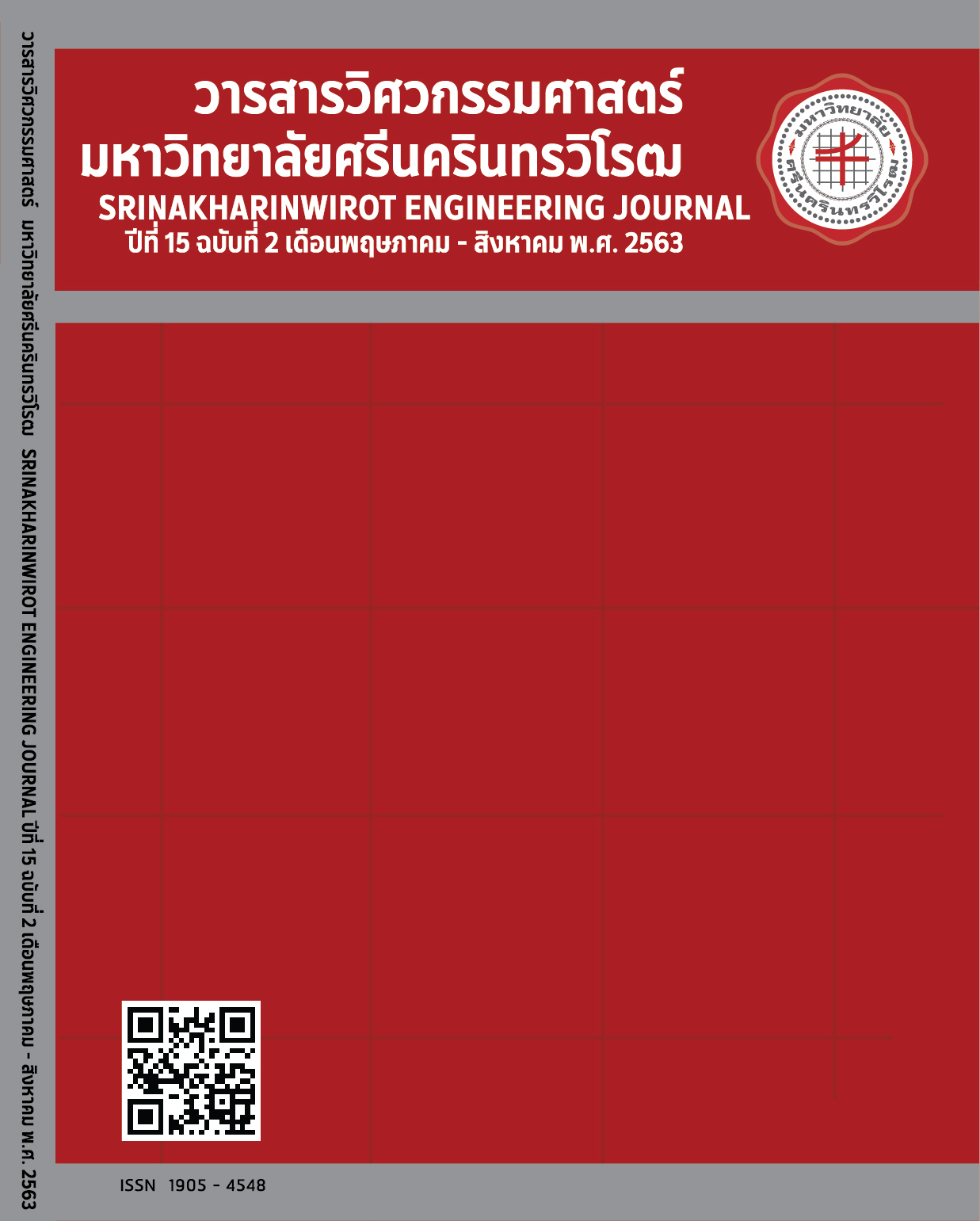A Study on Adsorption Efficiency of Methylene Blue Dye using Adsorbent Material Prepared from Water Hyacinth
Main Article Content
Abstract
An adsorbent for methylene blue dye (MB) adsorption in wastewater was prepared from water hyacinth. The adsorbent is prepared from water hyacinth powder with a particle size smaller than 2 mm, water hyacinth pretreated with sodium hydroxide (NaOH) and water hyacinth modified to biochar. Highest Iodine Number (I.N.) is 636.30±4.16 mg g-1 was obtained when water hyacinth was modified to biochar. The chemical structure of the three adsorbents was characterized by the Fourier Transform Infrared Spectroscopy (FT – IR) also found similar spectra of the adsorbents that showed important functional groups in cellulose. Moreover, the effects of contact time, adsorbents dose on the adsorption capacity, and adsorption isotherm were studied. The results indicated that the optimum conditions were the contact time of eight hours and the adsorbents dose of 20 g L-1. The adsorption isotherm of MB by the adsorbents was best described by the Langmuir isotherm which indicated the monolayer. The adsorption capacity of MB by biochar was the best efficiency, with an adsorption capacity of 21.88 mg g-1.
Article Details
Copyright belongs to Srinakharinwirot University Engineering Journal
References
A. Ritthichai and S. Muncharoen, “Dye Removal of Textile Wastewaters using Crab Shell Activated Carbon,” Burapha Science Journal, vol. 19, pp. 131-140, 2014. (in Thai).
P. Daengbutdee, et al., “Adsorption of Methylene Blue Dye by Rice-husk in Fixed-bed Column,” The Journal of KMUTNB, vol. 24(2), pp. 398-408, 2014. (in Thai).
V.K. Gupta and Suhas, “Application of low-colt adsorption for dye-removal: A review,” Journal of Environmental Management, vol. 90(8), pp. 2313-2342, 2009.
I.D. Mall, et al, “Removal of orange-G and methyl violet dyes by adsorption onto bagasse fly ash-kinetic study and equilibrium isotherm analyses,” Dyes and Pigments, vol. 69, pp. 210-223, 2006.
O. Hamdaoui, “Dynamic sorption of methylene blue by cedar sawdust and crushed brick in fixed bed column,” Journal of Hazardous Materials, vol. 138, pp. 293-303, 2006.
M. I. El-Khaiary, “Kinetics and mechanism of adsorption of methylene blue from aqueous solution by nitric-acid treated water-hyacinth,” Journal of Hazardous Materials, vol. 147 (1-2), pp. 28-36, 2007.
M.N. Uddin, “A Novel Biosorbent, Water-Hyacinth, Uptaking Methylene Blue from Aqueous Solution: Kinetics and Equilibrium Studies,” International Journal of Chemical Engineering vol. 2014, pp. 1-13, 2014.
X. Yan, et al., “Enhanced adsorption of methylene blue by citric acid modification of biochar derived from water hyacinth (Eichornia crassipes),” Environ Sci Pollut Res, vol. 23, pp. 23606–23618, 2016.
P. Prasannam, “Removal of heavy metal ions from solution using ion exchangers based on hydroxyethyl cellulose,” M.S. thesis, Dept. Eng., Silpakorn Univ., Nakhon Pathom, Thailand, 2004. (in Thai)
R.E. Masto, et al., “Biochar from water hyacinth (Eichornia crassipes) and its impact on soil biological activity,” Catena, vol.111, pp.64-71, 2013.
ASTM for Standard Test Method for Chemical Analysis of Wood Charcoal, ASTM Standards D1762-84, 2007.
ASTM for Standard Test Method for Analysis of Wood Fuels, ASTM Standards E870-82, 2019.
ASTM for Standard Test Method for Determination of Iodine Number of Activated Carbons, ASTM Standard D4607-94, 1998.
J. Guo and A.C. Lua, “Kinetic Study on Pyrolysis Process of Oil-Palm Stone Using Two-Step Consecutive Reaction Model,” Biomass and Bioenergy, vol.20, pp.223-233, 2001.
F. Li, et al., “Preparation and Characterization of Biochars from Eichornia crassipes for Cadmium Removal in Aqueous Solutions,” PLoS ONE, vol. 11(2), pp. 1-13, 2016.
T. Mimmo, et al., “Effect of Pyrolysis Temperature on Miscanthus (Miscanthus x Giganteus) Biochar Physical, Chemical and Functional Properties,” Biomass and Bioenergy, vol. 6(March), pp. 149-157, 2014.
S. Polpasert, “Pretreatment of lignocellulose materials for ethanol production,” Journal of Science and Technology, vol. 5, pp. 641-649, 2014. (in Thai)
TISI for Thai Industrial Standard: Activated Carbon, TISI Standard 900-2547, 2547. (in Thai)
D. Özer, et al., “Methylene blue adsorption from aqueous solution by dehydrated peanut hull,” Journal of Hazardous Materials, vol.144, pp.171-179, 2007.
R. Srimoon. “Dyes treatment in wastewater using adsorption processes,” KKU Sci. J., vol. 44(3), pp. 419-434, 2016. (in Thai).
A. Sukadjasakul. “Dyes removal from Doi Tung development project textile wastewater utilizing adsorbent from water hyacinth and Cyperus corymbosus Rottb.,” M.S. thesis, Env. Sci., Kasetsart Univ., Bangkok, Thailand, 2012. (in Thai).
S. Waiyasusri. “Phosphate removal in wastewater by adsorption on calcium carbonate and calcium oxide from eggshell,” The Journal of KMUTNB, vol. 26(3), pp. 475-486, 2016. (in Thai).
F. Nady, et al., “Effectiveness of alkali-acid treatment in enhancement the adsorption capacity for rice straw: The removal of methylene blue dye,” Physical chemistry, vol. 2013, pp. 1-15, (2013).
J. d. S. Macedo, et al., “Kinetic and calorimetric study of the adsorption of dyes on mesoporous activated carbon prepared from coconut coir dust,” Journal of Colloid and Interface Science, vol. 298, pp. 515-522, 2006.
J. Zhang, and Q. Wang, “Sustainable mechanisms of biochar derived from brewer’s spent grain and sewage for ammonia-nitrogen capture,” J. Cleaner. Prod., vol. 112, pp. 3927-3934, 2016.
X.L. Long, et al., “Adsorption of ammonia on activated carbon from aqueous solutions,” Environ. Prog., vol. 27(2), pp. 225-233, 2008.
G. Nibret, et al., “Removal of Methylene Blue Dye from Textile Wastewater using Water Hyacinth Activated Carbon as Adsorbent: Synthesis, Characterization and Kinetic studies,” International Conference on Sustainable Computing in Science, Technology & Management, Jaipur, India, 2019, pp. 1959-1969.


